Evaluation of the Variability of Micro and Macro Spray Parameters as a Function of Sampling Time Using a Laser Doppler Analyzer
Abstract
1. Introduction
2. Materials and Methods
3. Results and Discussion
4. Conclusions
Author Contributions
Funding
Institutional Review Board Statement
Informed Consent Statement
Data Availability Statement
Conflicts of Interest
References
- Jalu, V.J.; Yadav, R.; Ambaliya, P.S. A comprehensive review of various types of sprayers used in modern agriculture. Pharma Innov. 2023, 12, 143–149. [Google Scholar]
- Dorr, G.J.; Hewitt, A.J.; Adkins, S.W.; Hanan, J.; Zhang, H.; Noller, B.A. A comparison of initial spray characteristics produced by agricultural nozzles. Crop Prot. 2013, 53, 109–117. [Google Scholar] [CrossRef]
- Griesang, F.; Decaro, R.A.; dos Santos, C.A.M.; Santos, E.S.; de Lima Roque, N.H.; da Costa Ferreira, M. How Much Do Adjuvant and Nozzles Models Reduce the Spraying Drift? Drift in Agricultural Spraying. Am. J. Plant Sci. 2017, 8, 2785–2794. [Google Scholar] [CrossRef]
- Kieloch, R.; Domaradzki, K. The influence of selected spraying parameters on two formulation of sulfonylurea herbicides effect. J. Cent. Eur. Agric. 2013, 14, 42–51. [Google Scholar] [CrossRef]
- Subr, A.; Milanowski, M.; Parafiniuk, S.; Sawa, J. Testing the Uniformity of Spray Distribution Under Different Application Parameters. In Proceedings of the IX International Scientific Symposium “Farm Machinery and Processes Management in Sustainable Agriculture”, Lublin, Poland, 22–24 November 2017; pp. 359–364. [Google Scholar]
- Martini, A.T.; Schlosser, J.F.; Gil, E.; de Farias, M.S.; dos Santos, G.O.; Bertollo, G.M.; Barberi, J.P. Agricultural Spray Inspection According to ISO 16122: Part II—Determination of the State of Use and Conservation of Agricultural Sprayers. J. Agric. Sci. 2019, 11, 60–75. [Google Scholar] [CrossRef]
- Godyń, A.; Doruchowski, G.; Hołownicki, R.; Świechowski, W. Metodyka Badania Stanu Technicznego Opryskiwaczy Montowanych na Pojazdach Kolejowych. Inżynieria Rol. 2013, 3, 67–76. [Google Scholar]
- Kole, J.; Harasta, P. Quality Assurance as a Key Point in Effective Sprayer Inspection Schemes. JKI Open J. Syst. 2015, 5, 73–80. [Google Scholar]
- Parafiniuk, S.; Milanowski, M. Liquid outflow intensity as a determinant of operational quality of agricultural sprayers. Acta Sci. Pol. 2013, 12, 39–45. [Google Scholar]
- Koprowski, M.; Lodwik, D.; Pietrzyk, J. Evaluation of the spectrum of drops produced in the aspect of the outlet hole geometry. Przemysł Chem. 2024, 103, 1296–1299. [Google Scholar]
- Li, X.; Lu, D.; Wang, S.; Zhang, M.; Lei, X.; Lv, X. Droplet Distribution and Airflow Simulation of a Newly Designed Agricultural Twin Fluid Nozzle. Int. Agric. Eng. J. 2019, 28, 194–202. [Google Scholar]
- Laryea, G.L.; No, S.-Y. Development of Electrostatic Pressure-swirl Nozzle for Agricultural Applications. J. Electrost. 2003, 57, 129–142. [Google Scholar] [CrossRef]
- Chethan, C.R.; Singh, P.K.; Dubey, R.P.; Singhariya, S.; Choudhary, V.K. Herbicide Application in Agriculture: Nozzle Selection and Effective Application. Indian Farming 2018, 68, 28–30. [Google Scholar]
- Dowlati, M.; Khoshnam, F.; Namjoo, M.; Mirshahi, E. Analysis of Nozzle Spray Distribution for Different Nozzle Height and Pressure. Agric. Eng. Int. 2022, 24, 61–67. [Google Scholar]
- Çetin, N.; Sağlam, C.; Demir, B. Determination of Spray Angle and Flow Uniformity of Spray Nozzles with Image Processing Operations. J. Anim. Plant Sci. 2019, 29, 1603–1615. [Google Scholar]
- Lodwik, D.; Pietrzyk, J.; Malesa, W. Analysis of Volume Distribution and Evaluation of the Spraying Spectrum in Terms of Spraying Quality. Appl. Sci. 2020, 10, 2395. [Google Scholar] [CrossRef]
- Lodwik, D.; Pietrzyk, J. Ocena odporności na znoszenie cieczy wybranych rozpylaczy w aspekcie nierównomierności poprzecznego rozkładu cieczy. Teka Kom. Motoryz. Energetyki 2017, 17, 65–70. [Google Scholar]
- ANSI/ASAE S572.1; Spray Nozzle Classification by Droplet Spectra. ASABE Standards: St. Joseph, MI, USA, 2009.
- Pascuzzi, S.; Manetto, G.; Santoro, F.; Cerutto, E. A Brief Review of Nozzle Spray Drop Size Measurement Techniques. In Proceedings of the 2021 IEEE International Workshop on Metrology for Agriculture and Forestry (MetroAgriFor), Trento-Bolzano, Italy, 3–5 November 2021. [Google Scholar]
- da Cunha, J.P.A.R.; dos Reis, E.F.; de Assunção, H.H.T.; Landim, T.N. Evaluation of droplet spectra of the spray tip AD 11002 using different techniques. Eng. Agric. 2019, 39, 476–481. [Google Scholar] [CrossRef]
- Privitera, S.; Manetto, G.; Pascuzzi, S.; Pessina, D.; Cerruto, E. Drop Size Measurement Techniques for Agricultural Sprays: A State-of-The-Art Review. Agronomy 2023, 13, 678. [Google Scholar] [CrossRef]
- Molnar-Irimie, A.; Ranta, O.; Stanila, S.; Marian, O. Study Regarding Methods and Techniques Used for Analysis of Spray Drift and Droplet Size Distribution by Agricultural Spraying Machines. Bull. Univ. Agric. Sci. Vet. Med. Cluj-Napoca 2025, 82, 1–11. [Google Scholar] [CrossRef]
- Hoffmann, W.C.; Hewitt, A.J. Comparison of three imaging systems for water-sensitive papers. Am. Soc. Agric. Biol. Eng. 2005, 21, 961–964. [Google Scholar] [CrossRef]
- Cerruto, E.; Failla, S.; Longo, D.; Manetto, G. Simulation of water sensitive papers for spray analysis. Agric. Eng. Int. CIGR J. 2016, 18, 22–29. [Google Scholar]
- Salyani, M.; Zhu, H.; Sweeb, R.D.; Pai, N. Assessment of spray distribution with water-sensitive paper. Agric. Ing. Int. CIGR J. 2013, 15, 101–111. [Google Scholar]
- Longo, D.; Manetto, G.; Papa, R.; Cerruto, E. Design and construction of a low-cost test bench for testing agricultural spray nozzles. Appl. Sci. 2020, 10, 5221. [Google Scholar] [CrossRef]
- Cerruto, E.; Manetto, G.; Privitera, S.; Papa, R.; Longo, D. Effect of Image Segmentation Thresholding on Droplet Size Measurement. Agronomy 2022, 12, 1677. [Google Scholar] [CrossRef]
- Sofija, V.M.; Cointault, F.; Vanggeyte, J.; Pietras, J.G.; Nuyttens, D. Spray Droplet Characterization from a Single Nozzle by High Speed Image Analysis Using an In-Focus Droplet Criterion. Sens. Agric. 2016, 16, 218. [Google Scholar]
- Hijazi, B.; Decourselle, T.; Vulgarakis, M.; Nuyttens, D.; Cointault, F.; Pieters, J.; Vamgeyte, J. The Use of High-Speed Imaging System for Applications in Precision Agriculture. In New Technologies: Trends, Innovations and Research; Constantin, V., Ed.; Intech: Bolton, UK, 2012; pp. 279–296. [Google Scholar]
- Vulgarakis Minov, S.; Cointault, F.; Vangeyte, J.; Pieters, J.G.; Nuyttens, D. Development of High-Speed Image Acquisition Systems for Spray Characterization Based on Single-Droplet Experiments. Trans. ASABE 2015, 58, 27–37. [Google Scholar]
- Huněk, A.; Bartoš, O. The Spray Measurement with Two Different Optical Methods. EPJ Web Conf. 2024, 299, 01015. [Google Scholar] [CrossRef]
- Fritz, B.K.; Hoffmann, W.C. Measuring spray droplet size from agricultural nozzles using laser diffraction. J. Vis. Exp. 2016, 115, e54533. [Google Scholar]
- Liu, X.; Doub, W.H.; Guo, C. Evaluation of droplet velocity and size from nasal spray devices using phase Doppler anemometry (PDA). Int. J. Pharm. 2010, 388, 82–87. [Google Scholar] [CrossRef]
- Sijs, R.; Kooij, S.; Holterman, H.J.; van de Zande, J.; Bonn, D. Drop Size Measurement Techniques for Sprays: Comparison of Image Analysis, Phase Doppler Particle Analysis, and Laser Diffraction. AIP Adv. 2021, 11, 015315-1–015315-9. [Google Scholar] [CrossRef]
- Holterman, H.J.; de Hoog, D. Droplet sizing of agricultural sprays, comparing PDA and Shadowgraphy. In Proceedings of the Fachtagung “Experimentelle Strömungsmechanik”, Munich, Germany, 5–7 September 2023; pp. 1–7. [Google Scholar]
- Kapulla, R.; Trautmann, M.; Güntay, S.; Dehbi, A.; Suckow, D. Comparison between Phase-Doppler Anemometry and Shadowgraphy Systems with Respect to Solid-Particle Size Distribution Measurements. In Lasermethoden in der Strömungsmesstechnik, 13; Dopheide, D., Müller, H., Strunck, V., Ruck, B., Leder, A., Eds.; GALA e.V. Deutsche Gesellschaft für Laser-Anemometrie: Braunschweig, Germany, 2006. [Google Scholar]
- Privitera, S.; Cerruto, E.; Manetto, G.; Lupica, S.; Nuyttens, D.; Dekeyser, D.; Zwertvaegher, I.; Furtado, M.R.; Costalonga Vargas, B. Comparison between Liquid Immersion, Laser Diffraction, PDPA, and Shadowgraphy in Assessing Droplet Size from Agricultural Nozzles. Agriculture 2024, 14, 1191. [Google Scholar] [CrossRef]
- Nuyttens, D.; Baetens, K.; De Schampheleire, M.; Sonck, B. PDPA laser-based characterisation of agricultural sprays. Agric. Eng. Int. CIGR J. 2006, 8, 1–18. [Google Scholar]
- ISO/FDIS 25358:2018; Crop Protection Equipment—Droplet-Size Spectra from Atomizers—Measurement and Classification. International Organization for Standardization (ISO): Geneva, Switzerland, 2018.
- Lodwik, D. Method of assessing the distribution of sprayed liquid using a laser Doppler analyzer. Przemysł Chem. 2024, 103, 1446–1449. [Google Scholar]
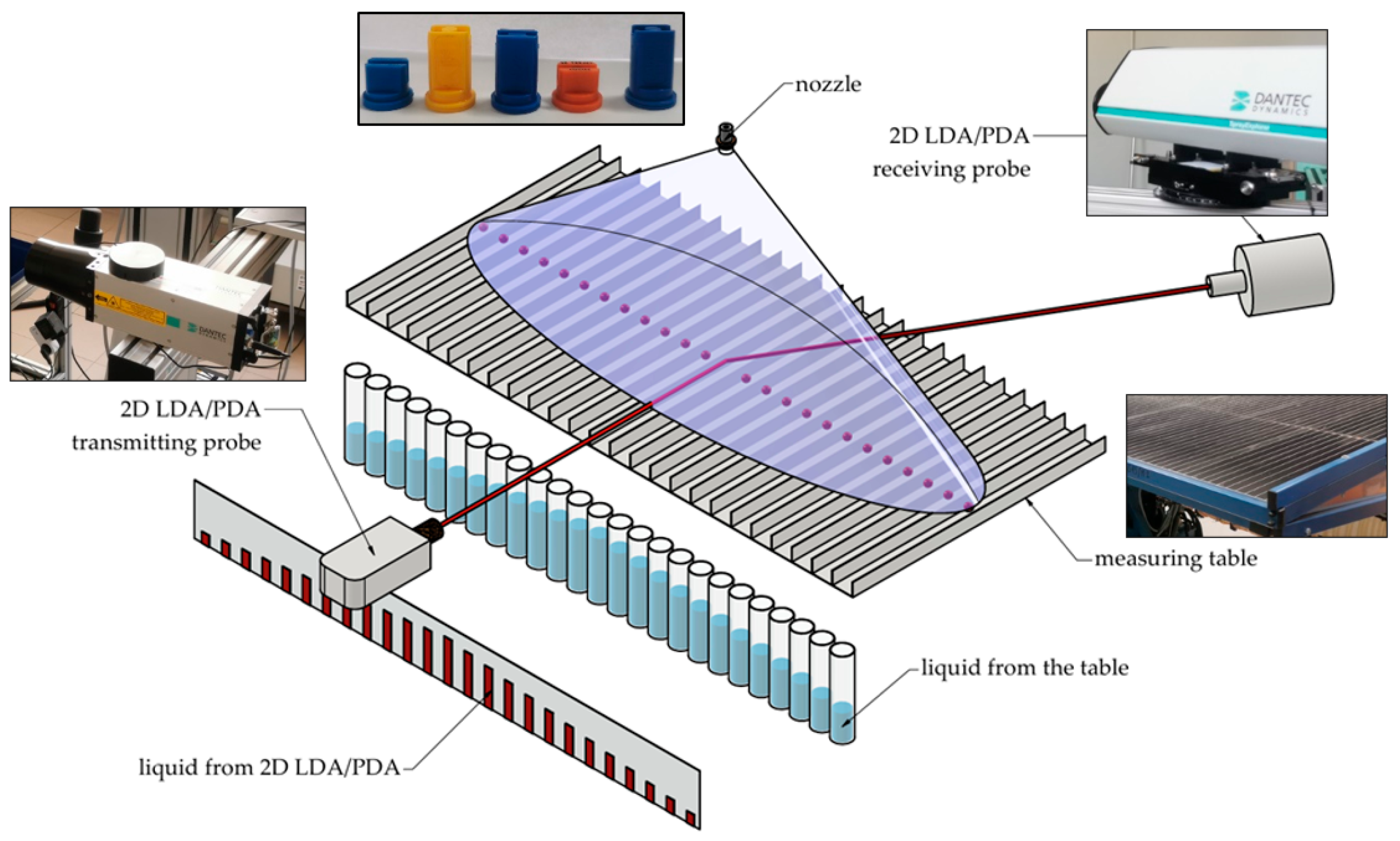
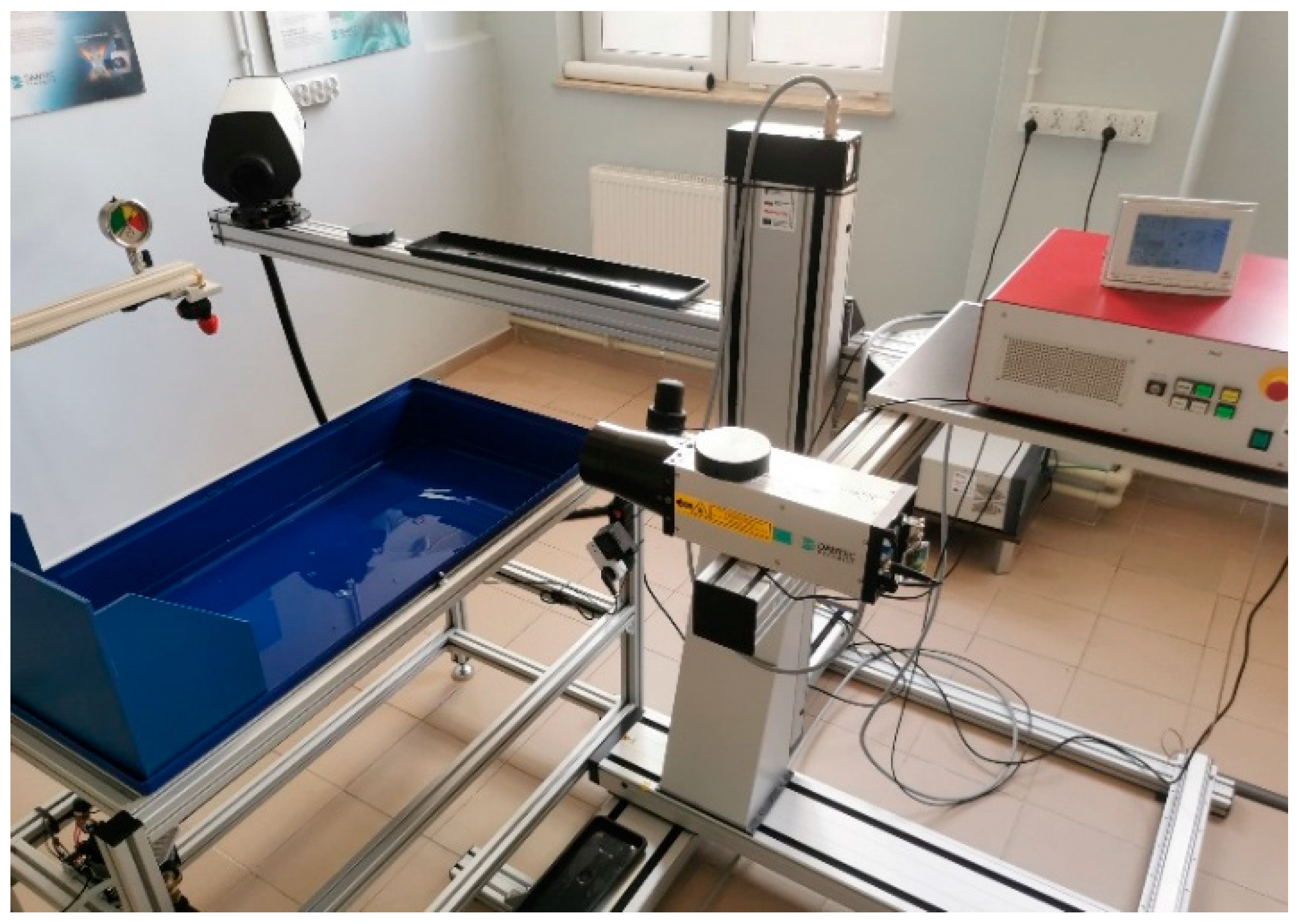


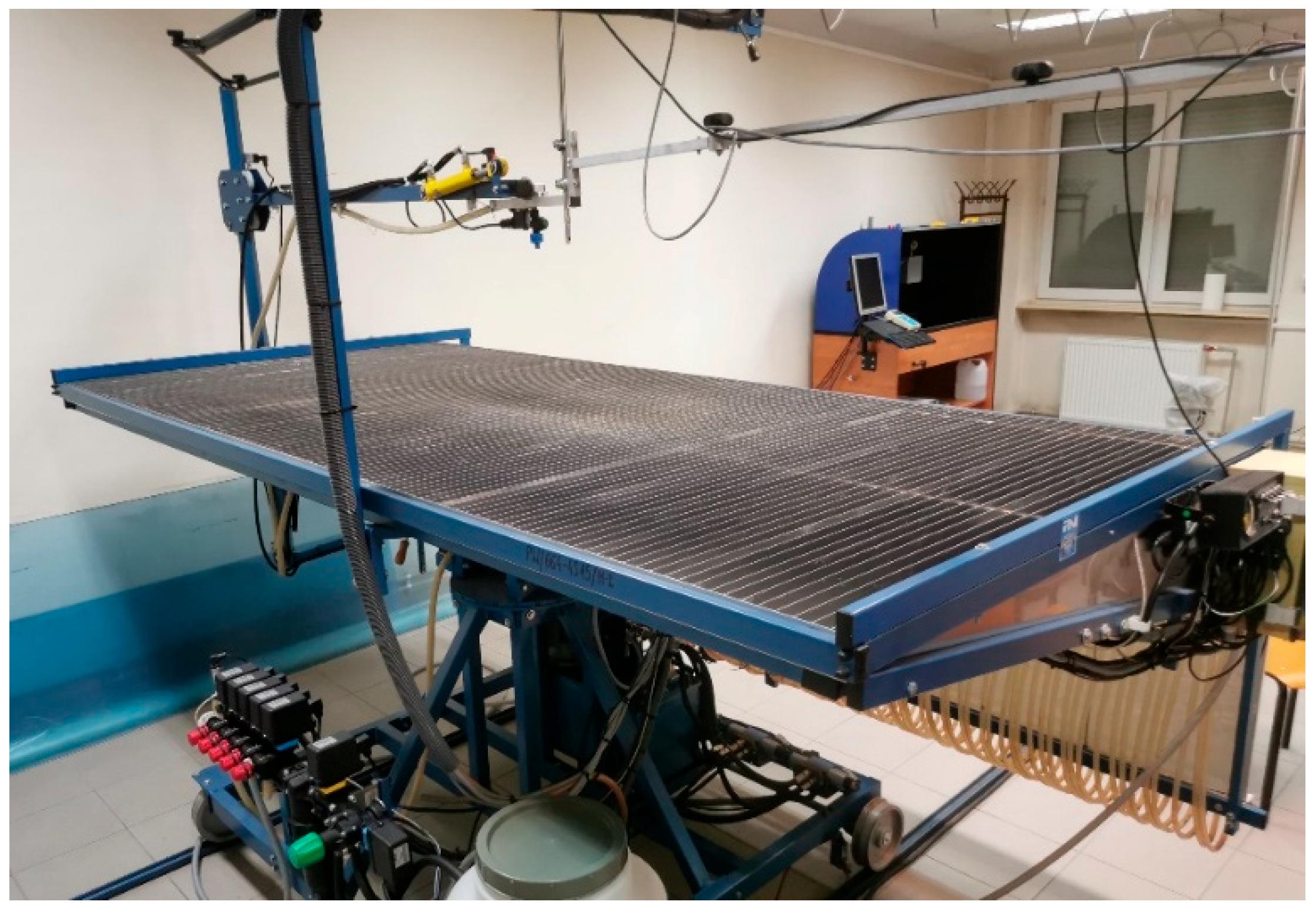
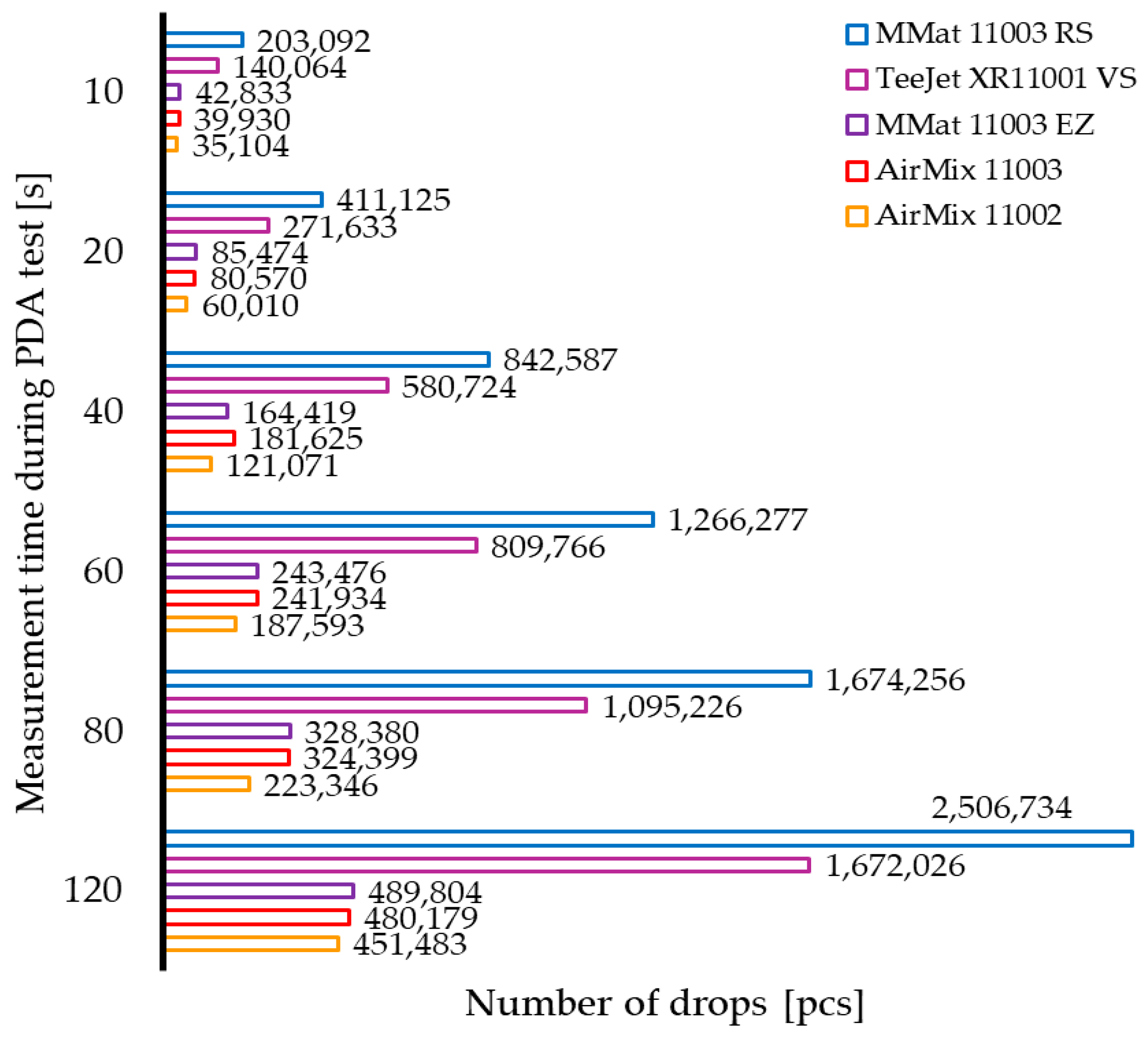
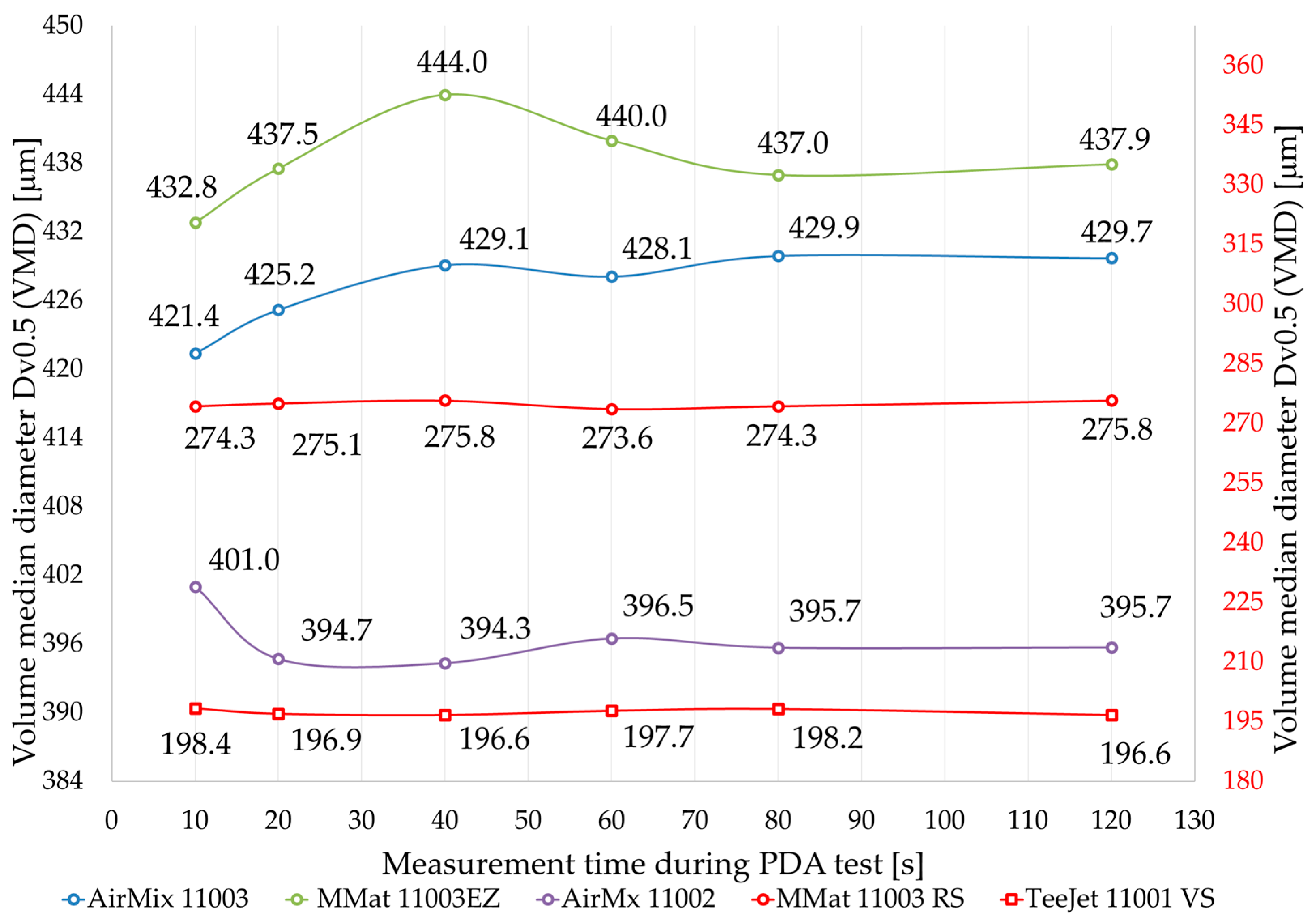

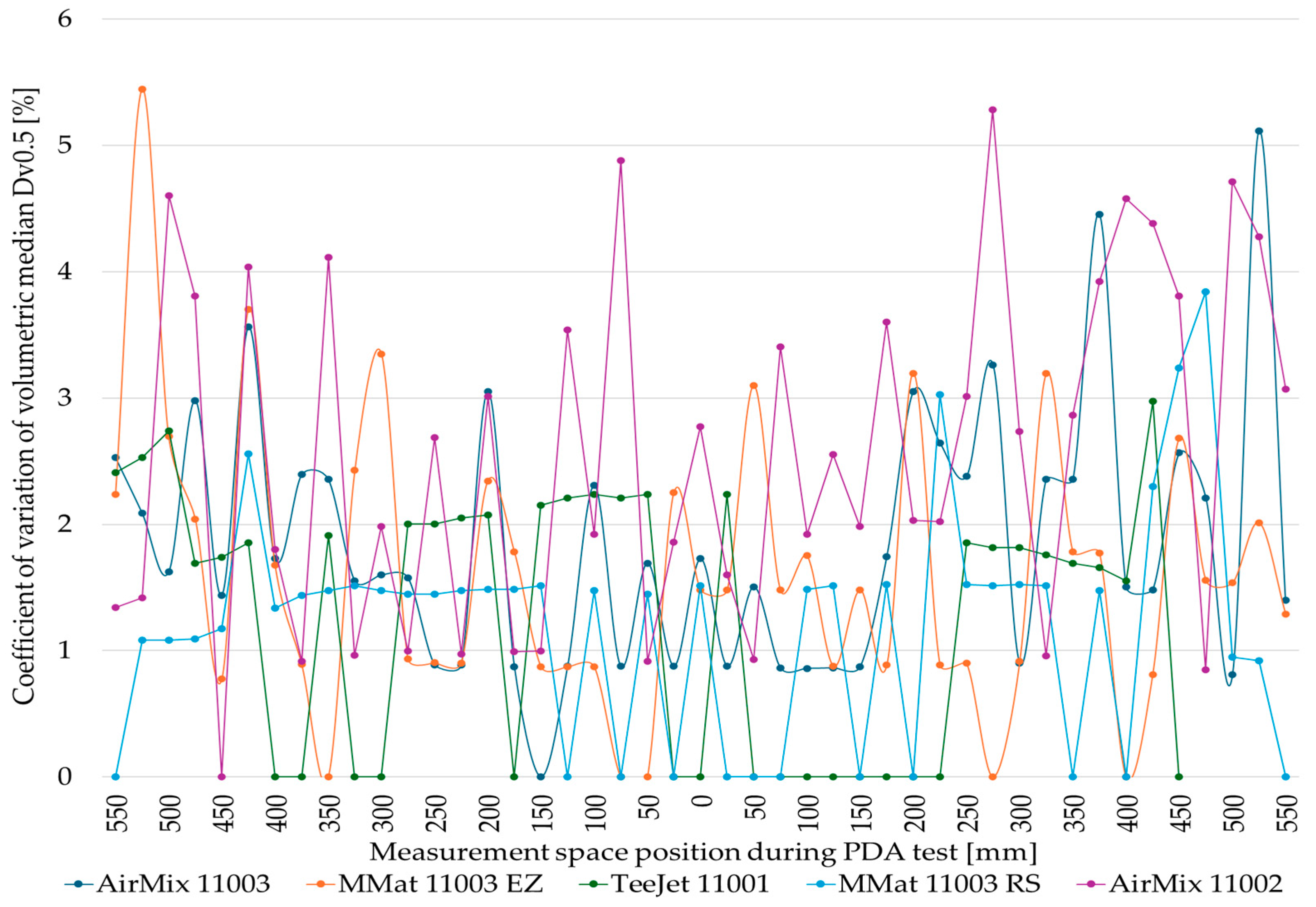

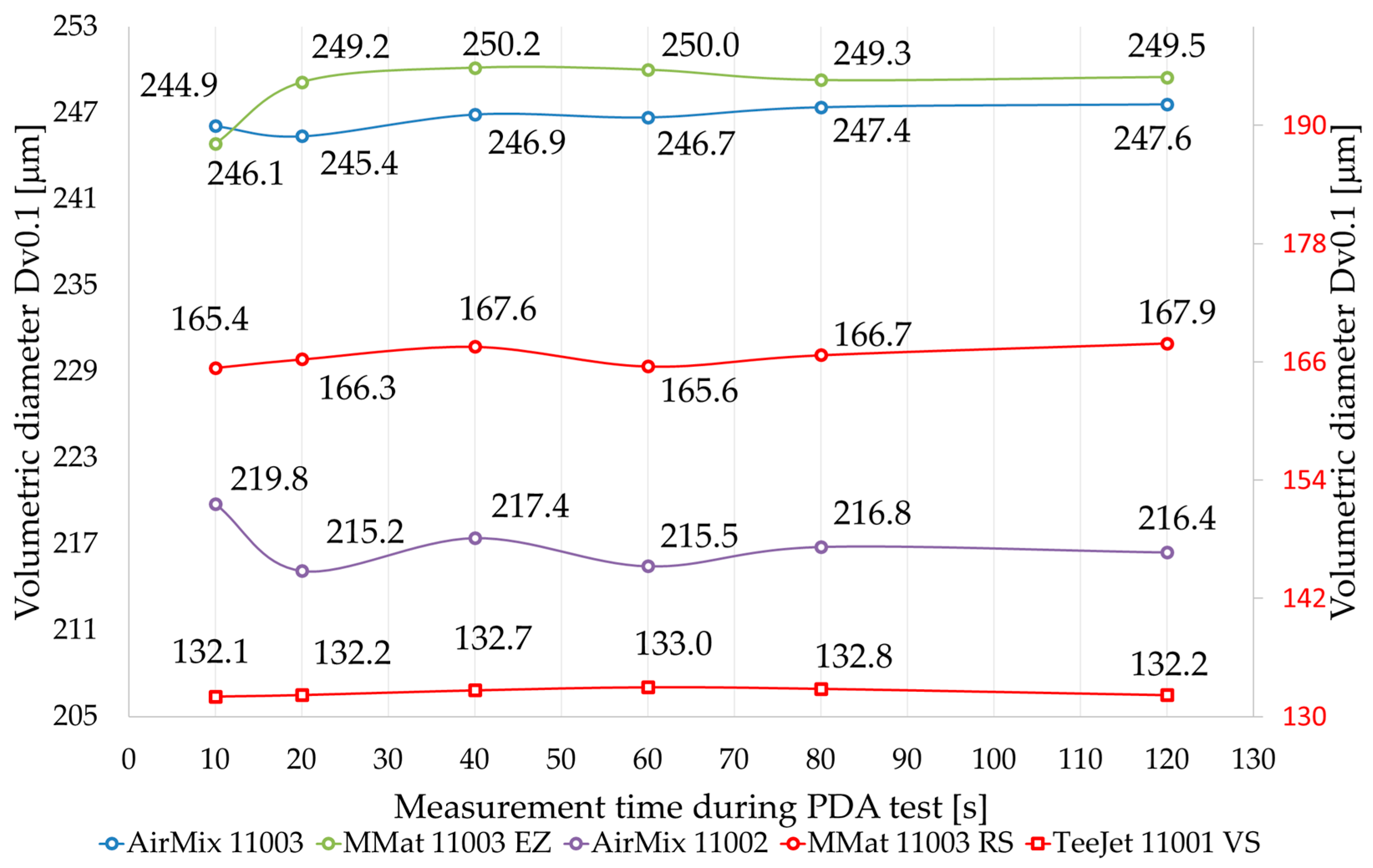
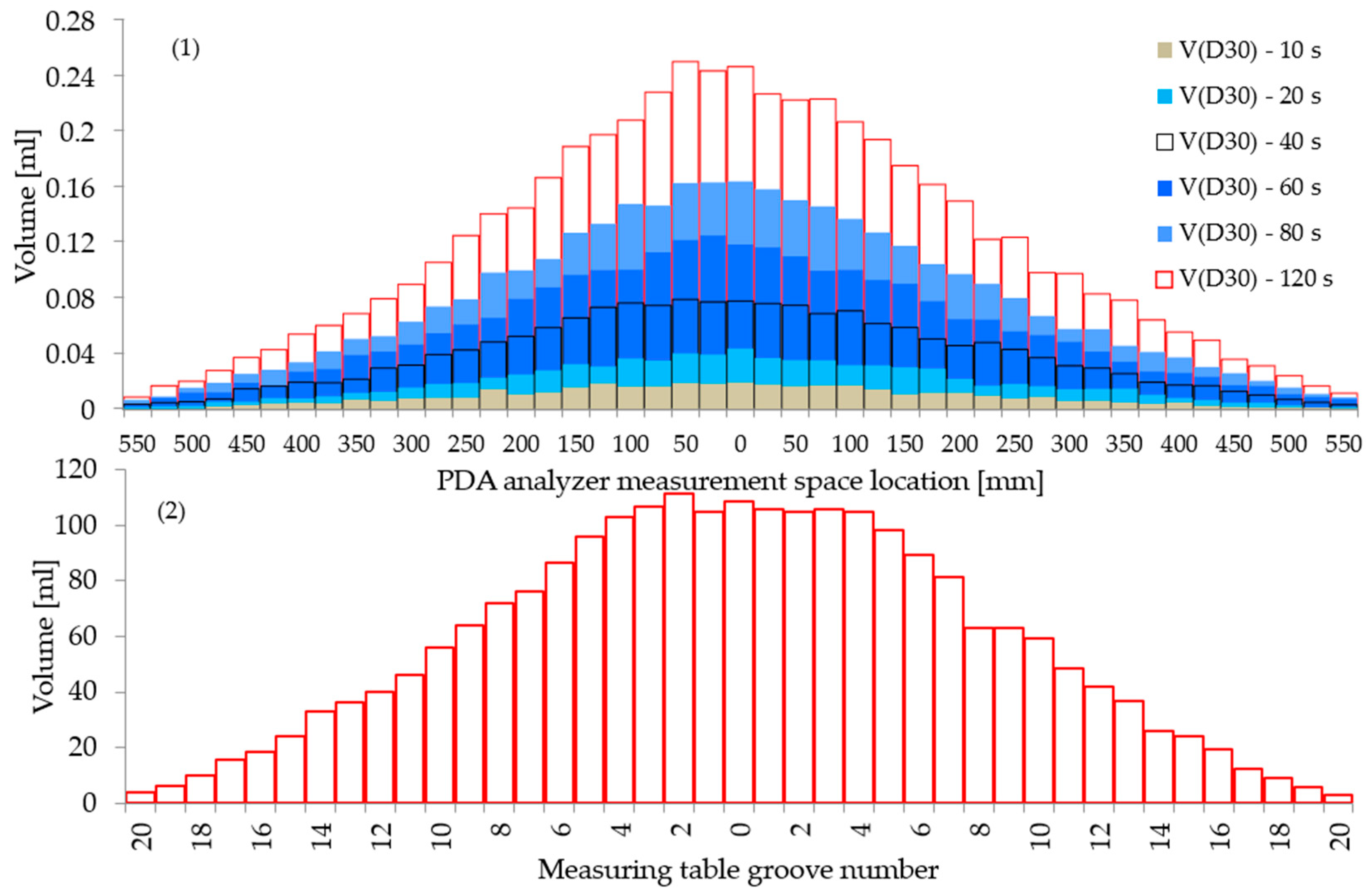
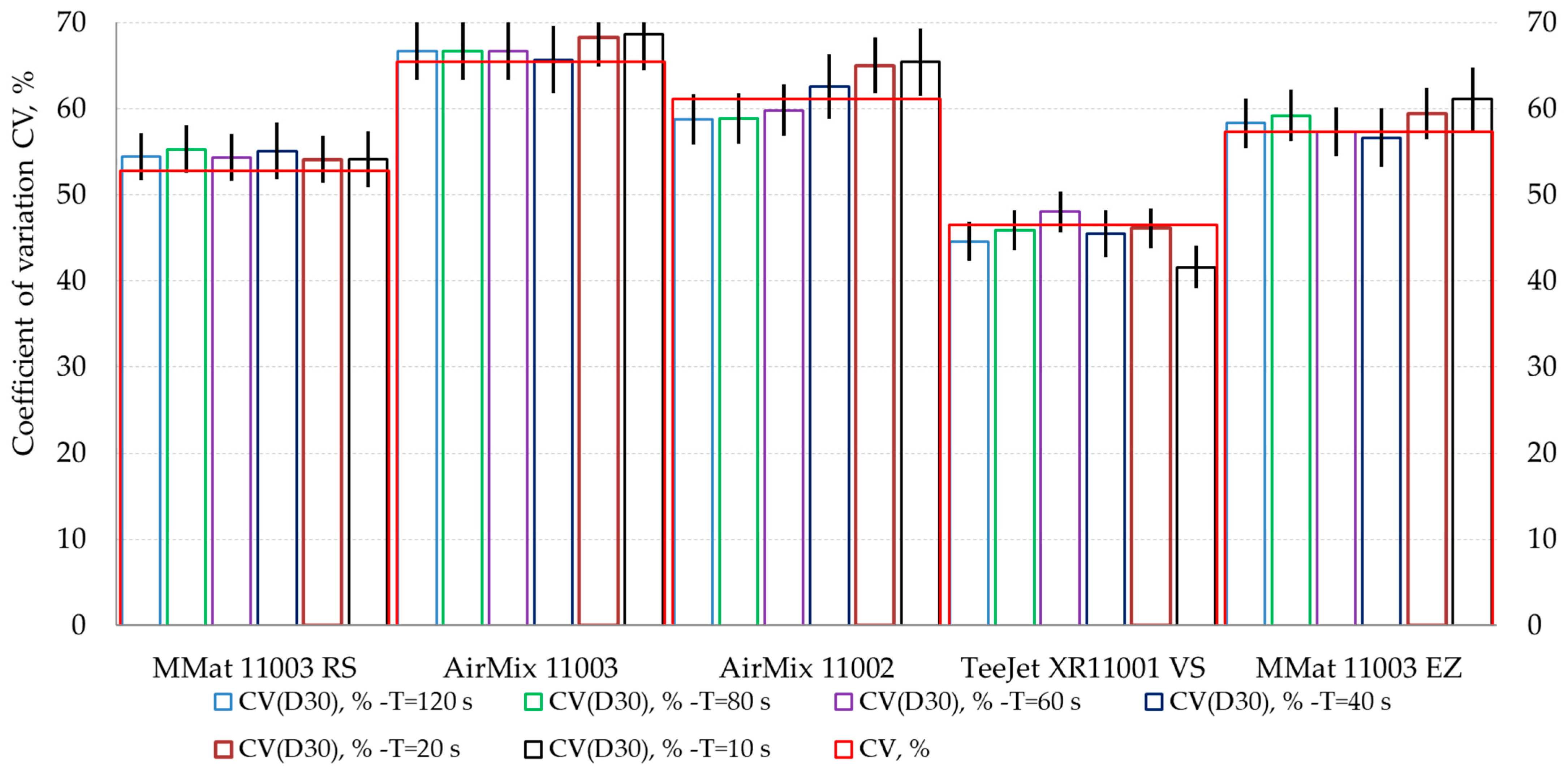
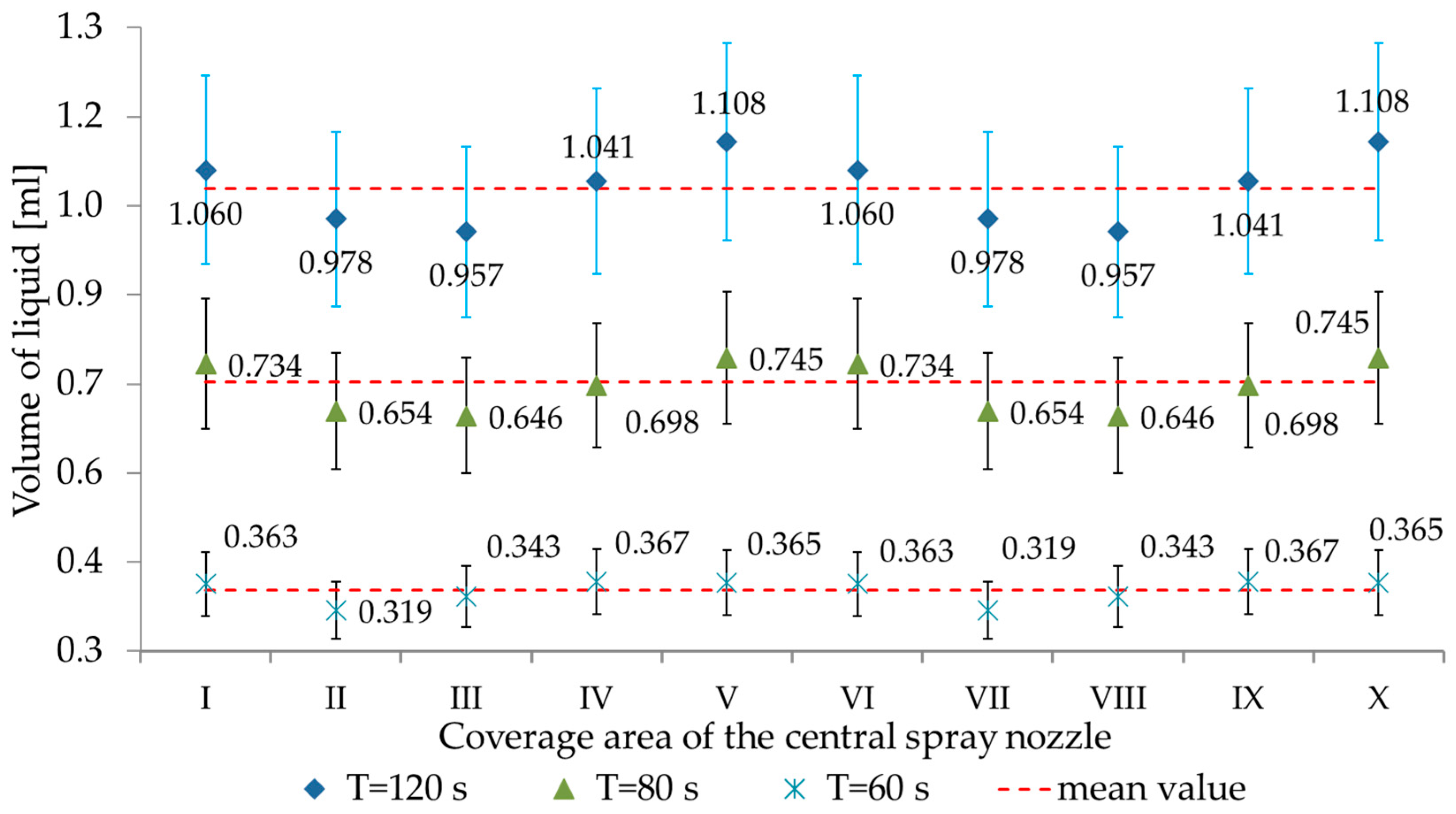
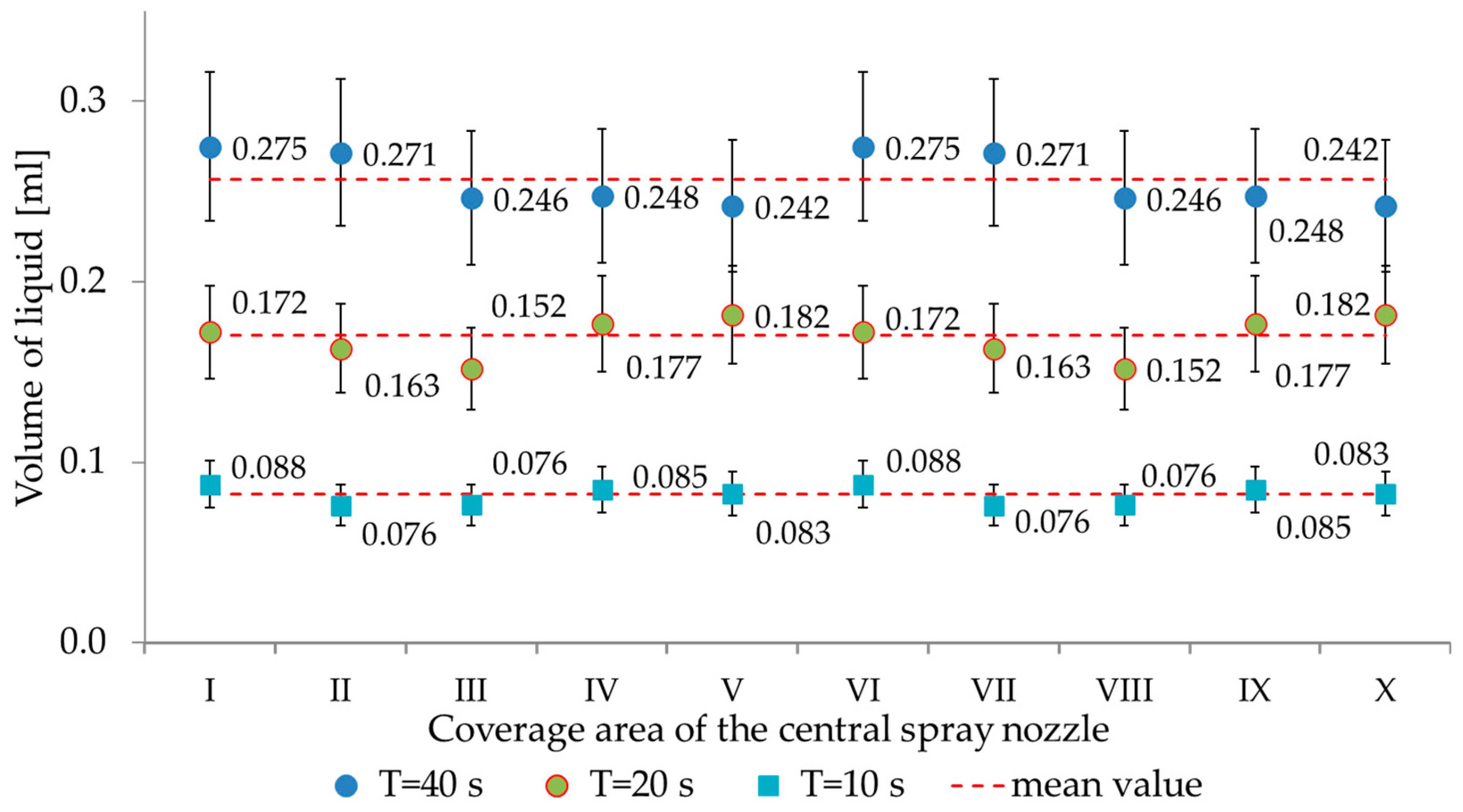
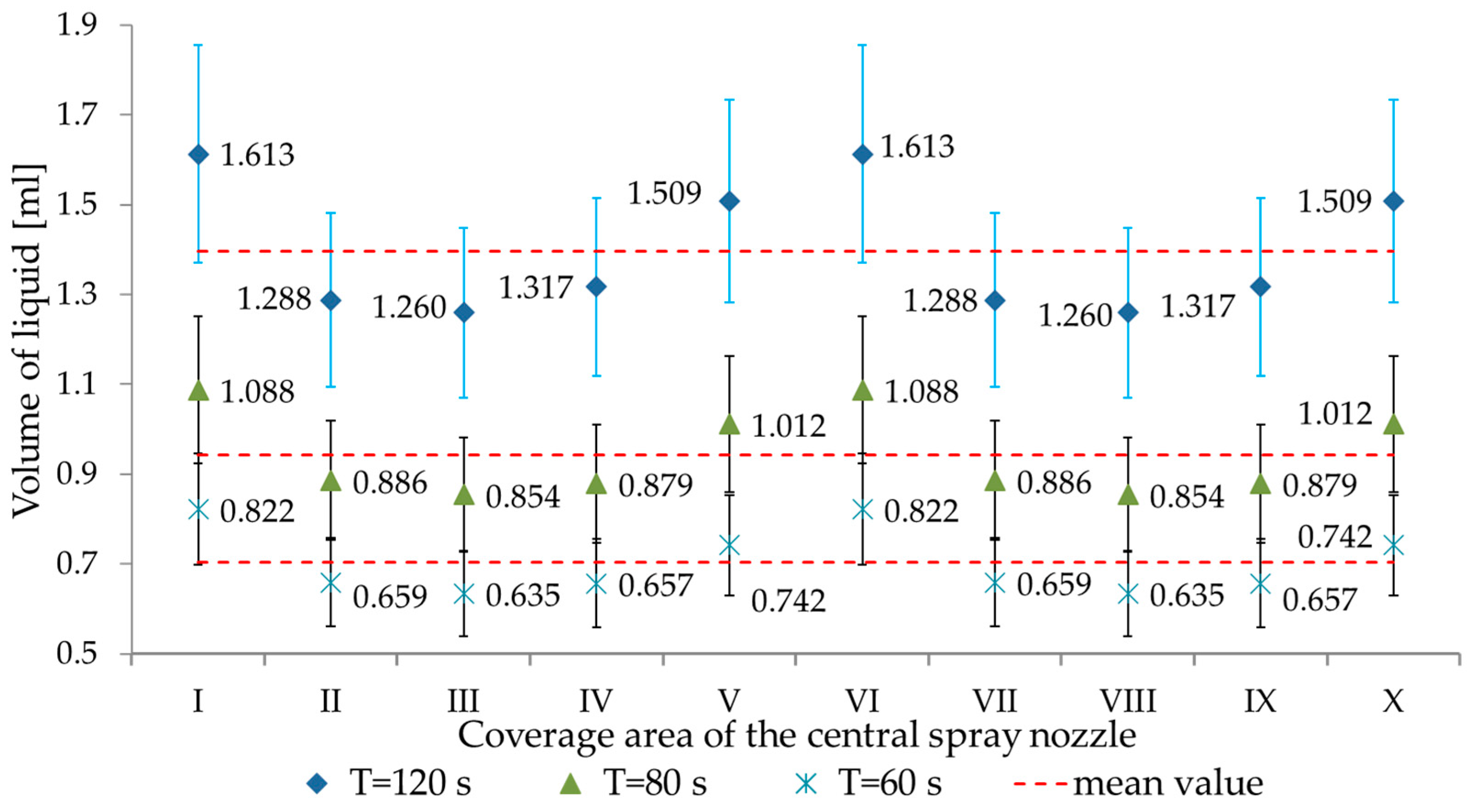
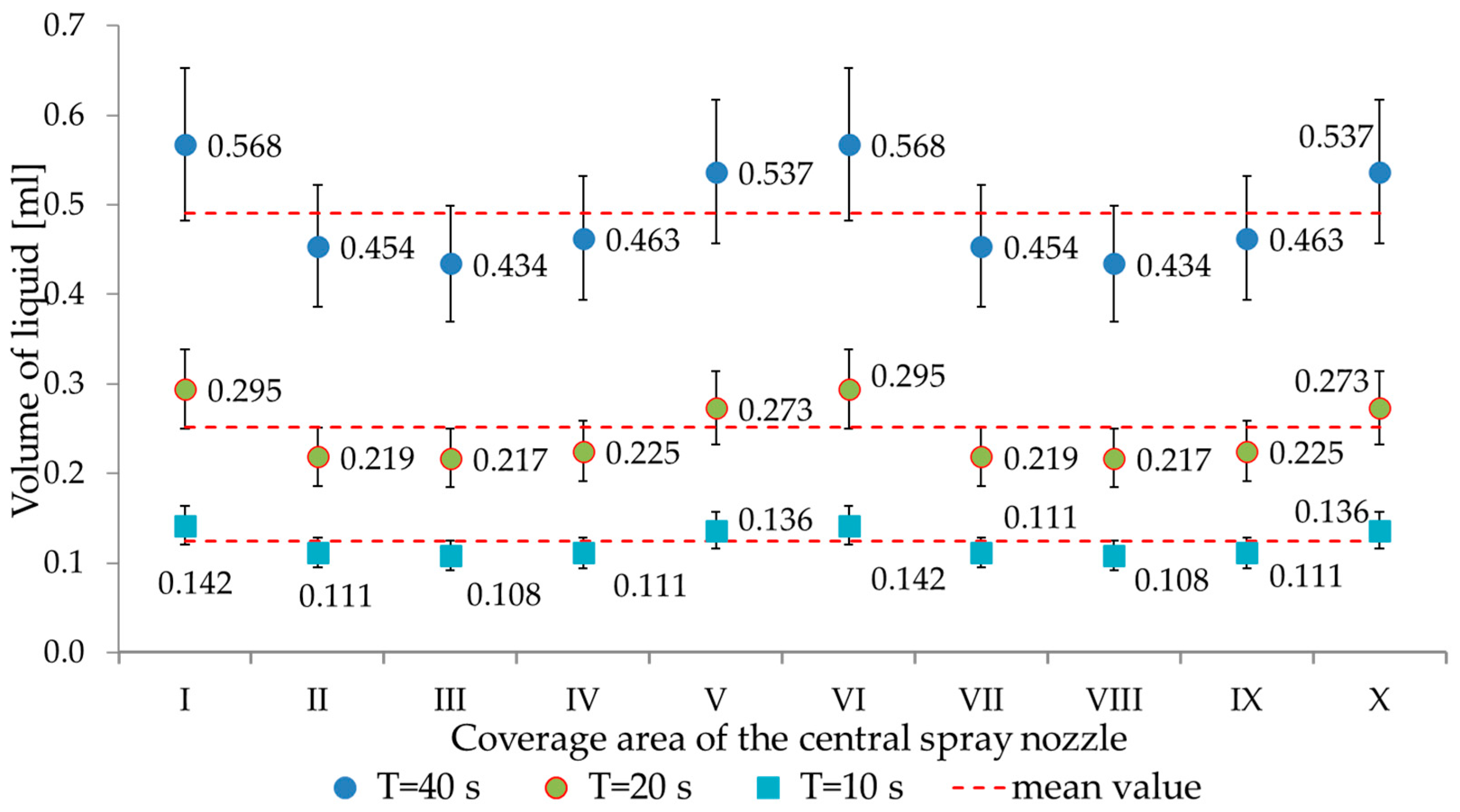
| Measurement Parameters | |
|---|---|
| size range of measured particles | 1–1600 µm |
| resolution of measured quantities | ±0.05 µm |
| maximum number of particles | >300,000 particles/s |
| range of measured velocity components at any vector turn | 0–300 m/s |
| resolution of measured speeds | 0.002% |
| Physical Parameters of the Transmitting and Receiving Probe | |
| probe focal length | 700 mm |
| wavelength of laser beams | 660 nm and 785 nm |
| laser power per pair of beams for the first component | 90 mW |
| laser power per pair of beams for the second component | 70 mW |
| diameter of the laser beam at the front lens | 2.75 mm ± 0.25 mm |
| type of bonnet of the receiving probe | B |
| medium droplet size | 644.2 µm |
| special filter | slit: 0.2 mm |
| scattering angle | 43.5 deg |
| phase validation ratio | 15% |
| burst detector SNR level | 2 dB |
| level validation ratio | 4 |
| data collection mode | burst |
| relative refractive index | 1.334 |
| confidence | 84.98% |
| best scattering | 138 deg |
| T | Dv0.5 | Dv0.1 | Dv0.9 | D10 | D30 | RSF | V100 | Number of Drops | |
|---|---|---|---|---|---|---|---|---|---|
| [s] | [mm] | [%] | pcs | ||||||
| AirMix 11003 AirMix 11003 | 120 | 429.7 | 247.6 | 573.2 | 243.8 | 305.7 | 0.75 | 0.38 | 480,179 |
| 80 | 429.9 | 247.4 | 573.4 | 245.1 | 305.8 | 0.76 | 0.38 | 324,399 | |
| 60 | 428.1 | 246.7 | 573.5 | 241.3 | 303.0 | 0.77 | 0.39 | 241,934 | |
| 40 | 429.1 | 246.9 | 573.8 | 221.7 | 293.1 | 0.77 | 0.44 | 181,625 | |
| 20 | 425.2 | 245.4 | 564.1 | 242.2 | 303.0 | 0.75 | 0.39 | 80,570 | |
| 10 | 421.4 | 246.1 | 560.6 | 242.6 | 301.6 | 0.75 | 0.42 | 39,930 | |
| MMat 11003 EZ | 120 | 437.9 | 249.5 | 578.3 | 241.3 | 305.4 | 0.76 | 0.41 | 489,804 |
| 80 | 437.0 | 249.3 | 577.1 | 241.2 | 305.3 | 0.76 | 0.41 | 328,380 | |
| 60 | 440.0 | 250.0 | 578.5 | 241.8 | 306.4 | 0.76 | 0.41 | 243,476 | |
| 40 | 444.0 | 250.2 | 580.5 | 243.8 | 307.9 | 0.75 | 0.40 | 164,419 | |
| 20 | 437.5 | 249.2 | 578.1 | 245.5 | 307.5 | 0.76 | 0.42 | 85,474 | |
| 10 | 432.8 | 244.9 | 575.1 | 241.5 | 302.8 | 0.77 | 0.41 | 42,833 | |
| TeeJet 11001VS | 120 | 196.6 | 132.2 | 295.4 | 139.4 | 161.7 | 0.85 | 5.19 | 1,672,026 |
| 80 | 198.2 | 132.8 | 295.3 | 141.3 | 163.2 | 0.84 | 5.15 | 1,095,226 | |
| 60 | 197.7 | 133.0 | 295.0 | 140.8 | 162.9 | 0.84 | 5.22 | 809,766 | |
| 40 | 196.6 | 132.7 | 294.2 | 142.2 | 163.4 | 0.84 | 5.30 | 580,724 | |
| 20 | 196.9 | 132.2 | 296.7 | 141.9 | 163.3 | 0.86 | 5.50 | 271,633 | |
| 10 | 198.4 | 132.1 | 298.1 | 139.5 | 162.2 | 0.86 | 5.38 | 140,064 | |
| MMat 11003RS | 120 | 275.8 | 167.9 | 414.9 | 163.8 | 203.8 | 0.93 | 2.40 | 2,506,734 |
| 80 | 274.3 | 166.7 | 413.8 | 162.5 | 202.4 | 0.92 | 2.36 | 1,674,256 | |
| 60 | 273.6 | 165.6 | 414.3 | 161.2 | 201.3 | 0.94 | 2.42 | 1,266,277 | |
| 40 | 275.8 | 167.6 | 414.9 | 166.1 | 205.0 | 0.93 | 2.29 | 842,587 | |
| 20 | 275.1 | 166.3 | 413.3 | 165.1 | 204.0 | 0.93 | 2.32 | 411,125 | |
| 10 | 274.3 | 165.4 | 413.9 | 163.2 | 202.6 | 0.93 | 2.28 | 203,092 | |
| AirMix 11002 | 120 | 395.7 | 216.4 | 555.1 | 223.2 | 277.1 | 0.85 | 0.62 | 451,483 |
| 80 | 395.7 | 216.8 | 555.6 | 232.5 | 283.4 | 0.86 | 0.57 | 223,346 | |
| 60 | 396.5 | 215.5 | 557.7 | 228.7 | 280.3 | 0.86 | 0.55 | 187,593 | |
| 40 | 394.3 | 217.4 | 553.0 | 218.4 | 274.3 | 0.85 | 0.68 | 121,071 | |
| 20 | 394.7 | 215.2 | 552.5 | 226.4 | 278.5 | 0.85 | 0.60 | 60,010 | |
| 10 | 401.0 | 219.8 | 543.8 | 226.2 | 280.9 | 0.81 | 0.66 | 35,104 | |
| Time | 60 s | 80 s | 120 s | ||||||||||
|---|---|---|---|---|---|---|---|---|---|---|---|---|---|
| Counts | D30 [μm] | Dv0.5 [μm] | Dv0.9 [μm] | Counts | D30 [μm] | Dv0.5 [μm] | Dv0.9 [μm] | Counts | D30 [μm] | Dv0.5 [μm] | Dv0.9 [μm] | ||
| Position of the measurement space of the PDA analyzer [mm] | 550 | 133 | 394.8 | 447.7 | 583.0 | 269 | 365.2 | 428.4 | 570.1 | 272 | 396.7 | 447.7 | 583.0 |
| 525 | 267 | 389.8 | 473.5 | 576.5 | 302 | 390.0 | 460.6 | 570.1 | 517 | 397.5 | 479.9 | 583.0 | |
| 500 | 395 | 388.8 | 454.1 | 570.1 | 514 | 387.8 | 467.0 | 589.4 | 664 | 387.4 | 454.1 | 576.5 | |
| 475 | 414 | 383.6 | 454.1 | 563.7 | 658 | 381.9 | 460.6 | 589.4 | 977 | 379.6 | 434.8 | 570.1 | |
| 450 | 724 | 369.9 | 447.7 | 570.1 | 977 | 368.4 | 441.3 | 550.8 | 1343 | 375.7 | 454.1 | 570.1 | |
| 425 | 819 | 343.4 | 409.0 | 531.4 | 1252 | 351.8 | 434.8 | 589.4 | 2010 | 344.3 | 409.0 | 557.2 | |
| 400 | 1293 | 342.2 | 434.8 | 570.1 | 1629 | 341.4 | 421.9 | 570.1 | 2657 | 338.7 | 434.8 | 563.7 | |
| 375 | 1611 | 325.1 | 409.0 | 557.2 | 2619 | 312.3 | 402.6 | 550.8 | 3329 | 325.8 | 421.9 | 557.2 | |
| 350 | 2486 | 310.8 | 415.5 | 589.4 | 3117 | 314.3 | 428.4 | 570.1 | 4101 | 317.5 | 409.0 | 557.2 | |
| 325 | 2896 | 301.4 | 415.5 | 570.1 | 3741 | 299.6 | 421.9 | 576.5 | 5817 | 296.6 | 409.0 | 563.7 | |
| 300 | 4052 | 279.9 | 396.2 | 550.8 | 5448 | 280.6 | 409.0 | 570.1 | 7881 | 279.1 | 402.6 | 563.7 | |
| 275 | 4932 | 276.7 | 415.5 | 570.1 | 7094 | 271.1 | 409.0 | 563.7 | 10,015 | 272.0 | 402.7 | 570.2 | |
| 250 | 6312 | 264.2 | 421.9 | 576.5 | 7371 | 273.6 | 415.5 | 570.1 | 11,739 | 272.8 | 421.9 | 570.1 | |
| 225 | 6762 | 264.7 | 421.9 | 570.1 | 9630 | 269.1 | 415.5 | 570.1 | 13,999 | 267.5 | 421.9 | 576.5 | |
| 200 | 7827 | 268.5 | 421.9 | 570.1 | 10,713 | 261.1 | 409.0 | 570.1 | 14,211 | 268.9 | 434.8 | 576.5 | |
| 175 | 9012 | 264.8 | 428.4 | 583.0 | 11,183 | 264.2 | 428.4 | 576.5 | 16,648 | 267.2 | 421.9 | 576.5 | |
| 150 | 9698 | 266.9 | 434.8 | 576.5 | 12,949 | 265.4 | 434.8 | 576.5 | 18,286 | 270.1 | 434.8 | 583.0 | |
| 125 | 10,596 | 262.3 | 421.9 | 570.1 | 13,988 | 263.0 | 428.4 | 576.5 | 20,624 | 263.3 | 421.9 | 576.5 | |
| 100 | 11,448 | 255.7 | 415.5 | 570.1 | 15,385 | 263.6 | 434.8 | 583.0 | 21,104 | 265.8 | 428.4 | 576.5 | |
| 75 | 12,236 | 260.1 | 421.9 | 576.5 | 15,308 | 263.3 | 421.9 | 583.0 | 23,358 | 265.1 | 428.4 | 576.5 | |
| 50 | 12,291 | 266.3 | 434.8 | 576.5 | 16,525 | 265.8 | 434.8 | 576.5 | 24,366 | 269.5 | 447.7 | 583.0 | |
| 25 | 13,033 | 263.5 | 428.4 | 583.0 | 17,455 | 261.3 | 421.9 | 563.7 | 25,323 | 263.6 | 421.9 | 576.5 | |
| 0 | 12,292 | 264.0 | 434.8 | 576.5 | 17,172 | 263.1 | 421.9 | 576.5 | 25,473 | 264.2 | 434.8 | 583.0 | |
| 25 | 11,647 | 267.2 | 428.4 | 570.1 | 16,983 | 261.0 | 421.9 | 570.1 | 24,502 | 260.4 | 421.9 | 570.1 | |
| 50 | 11,178 | 265.8 | 434.8 | 589.4 | 15,629 | 263.8 | 428.4 | 576.5 | 23,501 | 262.3 | 421.9 | 576.5 | |
| 75 | 10,889 | 259.4 | 428.4 | 589.4 | 14,928 | 265.2 | 434.8 | 583.0 | 22,617 | 266.0 | 428.4 | 576.5 | |
| 100 | 9999 | 267.4 | 434.8 | 583.0 | 14,437 | 262.5 | 428.4 | 583.0 | 20,689 | 267.1 | 434.8 | 583.0 | |
| 125 | 9251 | 267.7 | 434.8 | 570.1 | 12,980 | 265.4 | 428.4 | 570.1 | 19,958 | 264.6 | 428.4 | 576.5 | |
| 150 | 8932 | 268.2 | 421.9 | 576.5 | 12,168 | 264.2 | 428.4 | 576.5 | 17,750 | 266.0 | 428.4 | 583.0 | |
| 175 | 7552 | 269.9 | 434.8 | 576.5 | 10,637 | 265.6 | 421.9 | 576.5 | 16,304 | 266.4 | 421.9 | 576.5 | |
| 200 | 7145 | 258.7 | 409.0 | 570.1 | 9286 | 271.4 | 421.9 | 576.5 | 14,457 | 270.3 | 434.8 | 576.5 | |
| 225 | 5984 | 274.0 | 428.4 | 563.7 | 8561 | 272.0 | 428.4 | 576.5 | 12,448 | 265.6 | 409.0 | 563.7 | |
| 250 | 5863 | 263.4 | 402.6 | 576.5 | 7440 | 273.9 | 421.9 | 563.7 | 11,791 | 271.5 | 415.5 | 570.1 | |
| 275 | 4920 | 274.6 | 421.9 | 583.0 | 6243 | 273.9 | 415.5 | 563.7 | 9805 | 267.4 | 396.3 | 563.9 | |
| 300 | 4464 | 274.8 | 415.5 | 576.5 | 5011 | 280.4 | 409.0 | 563.7 | 8055 | 285.0 | 415.5 | 576.5 | |
| 325 | 3347 | 287.3 | 409.0 | 570.1 | 3931 | 303.7 | 428.4 | 576.5 | 6193 | 294.7 | 415.5 | 563.7 | |
| 350 | 2536 | 295.4 | 415.5 | 563.7 | 2864 | 312.5 | 409.0 | 570.1 | 4604 | 319.2 | 428.4 | 570.1 | |
| 375 | 1962 | 298.3 | 396.2 | 570.1 | 2012 | 339.6 | 428.4 | 570.1 | 3425 | 329.7 | 428.4 | 576.5 | |
| 400 | 1353 | 333.2 | 428.4 | 563.7 | 1808 | 340.6 | 421.9 | 576.5 | 2866 | 333.3 | 434.8 | 576.5 | |
| 425 | 1078 | 345.7 | 428.4 | 550.8 | 1271 | 358.0 | 441.3 | 557.2 | 2039 | 359.8 | 434.8 | 583.0 | |
| 450 | 688 | 364.1 | 428.4 | 589.4 | 979 | 370.6 | 447.7 | 589.4 | 1539 | 354.8 | 428.4 | 570.1 | |
| 475 | 596 | 377.3 | 447.7 | 570.1 | 751 | 373.6 | 434.8 | 550.8 | 1081 | 381.1 | 454.1 | 583.0 | |
| 500 | 417 | 369.6 | 454.1 | 583.0 | 540 | 381.8 | 460.6 | 576.5 | 777 | 390.5 | 460.6 | 583.0 | |
| 525 | 330 | 373.9 | 434.8 | 589.4 | 362 | 389.9 | 479.9 | 589.4 | 622 | 373.1 | 447.7 | 550.8 | |
| 550 | 274 | 373.0 | 467.0 | 602.3 | 279 | 391.9 | 454.1 | 583.0 | 442 | 369.0 | 460.6 | 563.7 | |
| Time | 10 s | 20 s | 40 s | ||||||||||
|---|---|---|---|---|---|---|---|---|---|---|---|---|---|
| Counts | D30 [μm] | Dv0.5 [μm] | Dv0.9 [μm] | Counts | D30 [μm] | Dv0.5 [μm] | Dv0.9 [μm] | Counts | D30 [μm] | Dv0.5 [μm] | Dv0.9 [μm] | ||
| Position of the measurement space of the PDA analyzer [mm] | 550 | 15 | 384.3 | 409.0 | 467.0 | 50 | 392.5 | 428.4 | 602.3 | 128 | 380.2 | 525.0 | 583.0 |
| 525 | 16 | 338.8 | 370.4 | 492.8 | 72 | 389.1 | 518.6 | 595.9 | 215 | 351.2 | 460.6 | 583.0 | |
| 500 | 24 | 406.0 | 454.1 | 602.3 | 164 | 311.9 | 396.2 | 525.0 | 236 | 355.8 | 447.7 | 576.5 | |
| 475 | 109 | 343.5 | 409.0 | 499.2 | 155 | 408.3 | 492.8 | 570.1 | 424 | 323.8 | 421.9 | 589.4 | |
| 450 | 120 | 371.2 | 434.8 | 557.2 | 230 | 358.8 | 447.7 | 576.5 | 533 | 376.3 | 486.4 | 595.9 | |
| 425 | 142 | 393.7 | 447.7 | 576.5 | 309 | 368.8 | 434.8 | 550.8 | 656 | 364.9 | 434.8 | 589.4 | |
| 400 | 248 | 336.5 | 421.9 | 563.7 | 378 | 341.8 | 415.5 | 557.2 | 957 | 339.0 | 428.4 | 550.8 | |
| 375 | 264 | 323.4 | 409.0 | 544.3 | 652 | 302.9 | 409.0 | 550.8 | 1242 | 308.7 | 396.2 | 544.3 | |
| 350 | 393 | 329.5 | 421.9 | 576.5 | 872 | 296.6 | 402.6 | 544.3 | 1805 | 284.3 | 396.2 | 544.3 | |
| 325 | 532 | 283.0 | 376.8 | 525.0 | 1086 | 281.3 | 402.6 | 557.2 | 2452 | 284.9 | 396.2 | 557.2 | |
| 300 | 674 | 284.8 | 409.0 | 595.9 | 1110 | 300.1 | 409.0 | 563.7 | 2739 | 280.8 | 421.9 | 595.9 | |
| 275 | 835 | 268.6 | 402.6 | 557.2 | 1569 | 281.3 | 409.0 | 576.5 | 3714 | 272.7 | 421.9 | 563.7 | |
| 250 | 933 | 260.1 | 409.0 | 583.0 | 2080 | 258.9 | 421.9 | 544.3 | 4572 | 261.4 | 409.0 | 563.7 | |
| 225 | 1330 | 276.6 | 421.9 | 583.0 | 2327 | 265.6 | 421.9 | 563.7 | 5034 | 263.9 | 421.9 | 583.0 | |
| 200 | 1349 | 249.7 | 396.2 | 537.9 | 2635 | 263.1 | 409.0 | 570.1 | 5572 | 262.0 | 421.9 | 570.1 | |
| 175 | 1309 | 262.4 | 402.6 | 537.9 | 2943 | 263.0 | 421.9 | 576.5 | 6375 | 260.1 | 421.9 | 576.5 | |
| 150 | 1546 | 270.7 | 409.0 | 557.2 | 3375 | 264.0 | 441.3 | 576.5 | 7375 | 257.2 | 441.3 | 583.0 | |
| 125 | 1737 | 274.5 | 441.3 | 583.0 | 3493 | 256.5 | 409.0 | 570.1 | 8158 | 257.9 | 434.8 | 563.7 | |
| 100 | 1827 | 259.0 | 409.0 | 576.5 | 3865 | 262.4 | 421.9 | 576.5 | 9013 | 252.9 | 428.4 | 563.7 | |
| 75 | 1913 | 255.6 | 434.8 | 570.1 | 3887 | 258.2 | 409.0 | 550.8 | 8983 | 251.3 | 428.4 | 583.0 | |
| 50 | 2103 | 258.6 | 434.8 | 583.0 | 4196 | 263.6 | 434.8 | 589.4 | 9497 | 251.4 | 421.9 | 576.5 | |
| 25 | 2298 | 249.0 | 409.0 | 563.7 | 4399 | 257.7 | 415.5 | 563.7 | 9521 | 249.2 | 415.5 | 570.1 | |
| 0 | 2241 | 255.0 | 409.0 | 557.2 | 4368 | 267.5 | 434.8 | 563.7 | 9192 | 252.8 | 415.5 | 570.1 | |
| 25 | 1830 | 266.0 | 441.3 | 589.4 | 4026 | 259.7 | 421.9 | 570.1 | 8713 | 255.5 | 441.3 | 589.4 | |
| 50 | 1804 | 261.1 | 441.3 | 557.2 | 3789 | 261.3 | 415.5 | 557.2 | 8892 | 252.3 | 434.8 | 583.0 | |
| 75 | 1802 | 264.1 | 415.5 | 570.1 | 3695 | 263.2 | 447.7 | 576.5 | 8395 | 250.1 | 421.9 | 583.0 | |
| 100 | 1644 | 272.4 | 428.4 | 595.9 | 3466 | 259.6 | 428.4 | 570.1 | 7703 | 259.9 | 441.3 | 583.0 | |
| 125 | 1668 | 254.7 | 396.2 | 576.5 | 3081 | 269.9 | 434.8 | 570.1 | 7130 | 254.6 | 421.9 | 576.5 | |
| 150 | 1407 | 246.4 | 409.0 | 550.8 | 2921 | 270.6 | 434.8 | 583.0 | 6415 | 259.7 | 421.9 | 570.1 | |
| 175 | 1382 | 255.8 | 415.5 | 570.1 | 2550 | 280.0 | 447.7 | 570.1 | 5952 | 253.3 | 409.0 | 576.5 | |
| 200 | 1196 | 268.4 | 409.0 | 563.7 | 2407 | 259.5 | 428.4 | 589.4 | 5240 | 255.7 | 415.5 | 570.1 | |
| 225 | 1042 | 264.2 | 434.8 | 576.5 | 2178 | 246.5 | 389.7 | 525.0 | 5171 | 260.9 | 421.9 | 570.1 | |
| 250 | 737 | 275.2 | 415.5 | 589.4 | 1800 | 269.2 | 434.8 | 595.9 | 4335 | 266.8 | 415.5 | 583.0 | |
| 275 | 928 | 266.3 | 434.8 | 570.1 | 1433 | 281.0 | 409.0 | 557.2 | 3435 | 274.5 | 415.5 | 570.1 | |
| 300 | 675 | 259.2 | 428.4 | 570.1 | 1302 | 277.4 | 415.5 | 563.7 | 2796 | 277.8 | 421.9 | 557.2 | |
| 325 | 519 | 287.4 | 396.2 | 537.9 | 986 | 306.1 | 428.4 | 570.1 | 2480 | 283.9 | 421.9 | 570.1 | |
| 350 | 414 | 286.2 | 421.9 | 557.2 | 841 | 324.0 | 428.4 | 583.0 | 1764 | 303.2 | 415.5 | 557.2 | |
| 375 | 239 | 321.1 | 389.7 | 583.0 | 591 | 323.9 | 434.8 | 557.2 | 1300 | 306.3 | 409.0 | 563.7 | |
| 400 | 222 | 353.8 | 434.8 | 576.5 | 404 | 340.2 | 441.3 | 550.8 | 985 | 323.7 | 415.5 | 557.2 | |
| 425 | 153 | 326.6 | 434.8 | 570.1 | 319 | 342.7 | 409.0 | 544.3 | 837 | 338.9 | 434.8 | 576.5 | |
| 450 | 110 | 327.0 | 409.0 | 512.1 | 175 | 375.5 | 447.7 | 550.8 | 592 | 346.9 | 434.8 | 589.4 | |
| 475 | 70 | 349.3 | 434.8 | 518.6 | 169 | 379.5 | 473.5 | 557.2 | 427 | 359.3 | 441.3 | 570.1 | |
| 500 | 77 | 344.7 | 402.6 | 512.1 | 111 | 370.6 | 460.6 | 544.3 | 274 | 369.2 | 460.6 | 570.1 | |
| 525 | 35 | 423.5 | 512.1 | 608.7 | 63 | 355.6 | 383.3 | 486.4 | 238 | 345.8 | 434.8 | 570.1 | |
| 550 | 18 | 464.5 | 512.1 | 583.0 | 48 | 405.9 | 486.4 | 595.9 | 158 | 346.2 | 460.6 | 608.7 | |
| AirMix 11003 | MMat 11003 EZ | TeeJet 11001VS | MMat 11003RS | AirMix 11002 | |
|---|---|---|---|---|---|
| Time T [s] | CV(D30) [%] | ||||
| 120 | 66.5 | 58.3 | 42.6 | 54.4 | 58.8 |
| 80 | 66.7 | 59.2 | 45.9 | 55.3 | 58.9 |
| 60 | 66.7 | 57.3 | 48.0 | 54.3 | 59.8 |
| 40 | 65.7 | 56.6 | 45.5 | 55.1 | 62.6 |
| 20 | 68.3 | 59.4 | 46.1 | 54.1 | 65.0 |
| 10 | 68.6 | 61.1 | 41.6 | 54.1 | 65.4 |
| CV [%] | |||||
| 120 | 65.9 | 57.1 | 46.3 | 53.1 | 60.1 |
| Coefficient of Variation, Submission of Results on the Virtual Boom/ Number of Cylinders Out of Range ± 15% of Average Volume Value | |||||||
|---|---|---|---|---|---|---|---|
| Groove Table—CVb [%] | Point Measurement with a PDA Analyzer—CV(D30)b [%] | ||||||
| Measurement Time T [s] | |||||||
| 120 | 120 | 80 | 60 | 40 | 20 | 10 | |
| AirMix 11003 | 3.91 | 5.64 | 5.96 | 5.09 | 5.66 | 6.28 | 5.83 |
| 0 | 0 | 0 | 0 | 0 | 0 | 0 | |
| MMat 11003 EZ | 9.04 | 10.1 | 10.35 | 11.20 | 10.08 | 11.72 | 13.41 |
| 0 | 0 | 0 | 0 | 2 | 2 | 2 | |
| MMat 11003 RS | 9.53 | 10.47 | 10.12 | 10.48 | 11.1 | 13.57 | 12.24 |
| 0 | 0 | 0 | 0 | 1 | 2 | 2 | |
| AirMix 11002 | 8.05 | 10.34 | 9.64 | 10.73 | 11.27 | 12.86 | 11.55 |
| 0 | 0 | 0 | 0 | 1 | 2 | 2 | |
| TeeJet 11001VS | 5.89 | 6.19 | 5.35 | 5.66 | 10.19 | 7.9 | 4.61 |
| 0 | 0 | 0 | 0 | 1 | 0 | 0 | |
Disclaimer/Publisher’s Note: The statements, opinions and data contained in all publications are solely those of the individual author(s) and contributor(s) and not of MDPI and/or the editor(s). MDPI and/or the editor(s) disclaim responsibility for any injury to people or property resulting from any ideas, methods, instructions or products referred to in the content. |
© 2025 by the authors. Licensee MDPI, Basel, Switzerland. This article is an open access article distributed under the terms and conditions of the Creative Commons Attribution (CC BY) license (https://creativecommons.org/licenses/by/4.0/).
Share and Cite
Lodwik, D.; Koprowski, M. Evaluation of the Variability of Micro and Macro Spray Parameters as a Function of Sampling Time Using a Laser Doppler Analyzer. Appl. Sci. 2025, 15, 6993. https://doi.org/10.3390/app15136993
Lodwik D, Koprowski M. Evaluation of the Variability of Micro and Macro Spray Parameters as a Function of Sampling Time Using a Laser Doppler Analyzer. Applied Sciences. 2025; 15(13):6993. https://doi.org/10.3390/app15136993
Chicago/Turabian StyleLodwik, Dariusz, and Mariusz Koprowski. 2025. "Evaluation of the Variability of Micro and Macro Spray Parameters as a Function of Sampling Time Using a Laser Doppler Analyzer" Applied Sciences 15, no. 13: 6993. https://doi.org/10.3390/app15136993
APA StyleLodwik, D., & Koprowski, M. (2025). Evaluation of the Variability of Micro and Macro Spray Parameters as a Function of Sampling Time Using a Laser Doppler Analyzer. Applied Sciences, 15(13), 6993. https://doi.org/10.3390/app15136993






